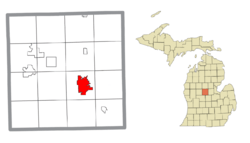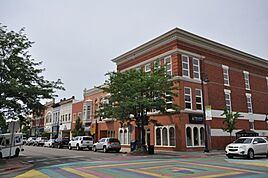Mount Pleasant, Michigan facts for kids
Quick facts for kids
Mount Pleasant, Michigan
|
||
|---|---|---|
| City of Mount Pleasant | ||
|
|
||
|
||
| Nickname(s):
"Oil Capital of Michigan"
|
||

Location within Isabella County
|
||
| Country | ||
| State | ||
| County | Isabella | |
| Incorporated | 1889 | |
| Government | ||
| • Type | Council–manager | |
| Area | ||
| • Total | 7.81 sq mi (20.23 km2) | |
| • Land | 7.72 sq mi (20.00 km2) | |
| • Water | 0.09 sq mi (0.23 km2) 1.15% | |
| Elevation | 771 ft (235 m) | |
| Population
(2020)
|
||
| • Total | 21,688 | |
| • Density | 2,808.60/sq mi (1,084.39/km2) | |
| Time zone | UTC-5 (EST) | |
| • Summer (DST) | UTC-4 (EDT) | |
| ZIP Code(s) | ||
| Area code(s) | 989 | |
| FIPS code | 26-56020 | |
| GNIS feature ID | 0632832 | |
Mount Pleasant is a city in the U.S. state of Michigan. It is the main city of Isabella County, located in Central Michigan. In 2020, about 21,688 people lived there. The city is surrounded by another area called Union Charter Township, but it runs its own government.
A large part of Mount Pleasant is inside the Isabella Indian Reservation. This is the home of the Saginaw Chippewa Tribal Nation. Their Soaring Eagle Casino & Resort is also nearby, within the reservation.
Mount Pleasant is known for its universities. It has the main campus of Central Michigan University, which is one of the biggest universities in Michigan. It also has Mid Michigan Community College. Many students live in Mount Pleasant, almost doubling its population during the school year. This makes it a true "college town." Even though it's called "Mount Pleasant," the area is mostly flat, without any mountains or big hills.
Contents
History of Mount Pleasant
Before the mid-1800s, the Ojibwa people lived in this area. They were also known as the Chippewa. Over time, they gave up large parts of their land to the United States government. This allowed European Americans to settle there.
In 1854, a law called the Graduation Act of 1854 made it easier for settlers to buy land cheaply. This is when the first white settlers arrived in what became Mount Pleasant. In 1855, the Ojibwa groups from other rivers moved to land in Isabella County. This land became the Isabella Indian Reservation.
Many non-Native people soon moved to Mount Pleasant. They hoped to have good relationships with the Native people. The Homestead Act of 1862 also brought new settlers, including immigrants from Europe. They worked to build homes and farms on the free land offered by the U.S. government.
The village grew into a city. In 1875, a big fire destroyed several buildings on Broadway. Seven years later, another fire caused damage on the same street.
In 1879, the first library opened in Mount Pleasant. It was called "The Library, Literary, and Musical Association of Mount Pleasant." Its first books came from the personal collections of the people who started it.
In 1890, a school called Mount Pleasant Business College began. It grew and changed its name to Central Michigan Normal School and Business Institute in 1892. This school started training teachers. It was the beginning of what is now Central Michigan University. The main campus in Mount Pleasant is the largest of CMU's locations.
On January 3, 1893, the U.S. government opened an Indian boarding school in Mount Pleasant. It was called the Mount Pleasant Indian Industrial Boarding School. Native American children were sent there and were expected to give up their culture and language. The school closed in 1933 after 40 years. Today, people understand the harm these schools caused. The Saginaw Chippewa Tribal Nation bought the old school building from the state of Michigan.
In 1928, a lot of oil was found near Mount Pleasant. The Lilly family farm was the first to find oil, producing hundreds of barrels each day. Even though the oil eventually ran out, this history is still important to the city. The city's seal has an oil drill on it. The Mount Pleasant High School mascot is the "Oiler," which also reminds people of the city's oil past. Because of this, the city became known as the "Oil Capital of Michigan."
Geography and Climate
Mount Pleasant covers about 7.83 square miles (20.23 square kilometers). Most of this area is land, and a small part is water. The Chippewa River flows through the city. Mount Pleasant is about 61 miles (98 km) north of Lansing, which is Michigan's state capital. You can reach it by following US 127.
Climate
| Climate data for Mount Pleasant, Michigan (Central Michigan University) 1991–2020 normals, extremes 1895–present | |||||||||||||
|---|---|---|---|---|---|---|---|---|---|---|---|---|---|
| Month | Jan | Feb | Mar | Apr | May | Jun | Jul | Aug | Sep | Oct | Nov | Dec | Year |
| Record high °F (°C) | 60 (16) |
67 (19) |
87 (31) |
91 (33) |
97 (36) |
103 (39) |
106 (41) |
108 (42) |
99 (37) |
88 (31) |
77 (25) |
69 (21) |
108 (42) |
| Mean daily maximum °F (°C) | 29.5 (−1.4) |
32.3 (0.2) |
42.7 (5.9) |
56.2 (13.4) |
69.4 (20.8) |
79.5 (26.4) |
83.7 (28.7) |
81.5 (27.5) |
74.0 (23.3) |
60.2 (15.7) |
45.8 (7.7) |
34.8 (1.6) |
57.5 (14.2) |
| Daily mean °F (°C) | 22.7 (−5.2) |
24.4 (−4.2) |
33.1 (0.6) |
45.1 (7.3) |
57.6 (14.2) |
68.0 (20.0) |
72.2 (22.3) |
70.2 (21.2) |
62.6 (17.0) |
50.3 (10.2) |
38.3 (3.5) |
28.6 (−1.9) |
47.8 (8.8) |
| Mean daily minimum °F (°C) | 15.9 (−8.9) |
16.5 (−8.6) |
23.6 (−4.7) |
34.0 (1.1) |
45.8 (7.7) |
56.5 (13.6) |
60.7 (15.9) |
59.0 (15.0) |
51.3 (10.7) |
40.5 (4.7) |
30.9 (−0.6) |
22.4 (−5.3) |
38.1 (3.4) |
| Record low °F (°C) | −25 (−32) |
−30 (−34) |
−18 (−28) |
−3 (−19) |
20 (−7) |
25 (−4) |
31 (−1) |
36 (2) |
27 (−3) |
13 (−11) |
−6 (−21) |
−14 (−26) |
−30 (−34) |
| Average precipitation inches (mm) | 2.11 (54) |
1.72 (44) |
1.95 (50) |
3.57 (91) |
3.71 (94) |
3.87 (98) |
3.22 (82) |
3.84 (98) |
2.82 (72) |
3.52 (89) |
2.79 (71) |
2.35 (60) |
35.47 (901) |
| Source: NOAA | |||||||||||||
Population and People
| Historical population | |||
|---|---|---|---|
| Census | Pop. | %± | |
| 1880 | 1,115 | — | |
| 1890 | 2,701 | 142.2% | |
| 1900 | 3,662 | 35.6% | |
| 1910 | 3,972 | 8.5% | |
| 1920 | 4,819 | 21.3% | |
| 1930 | 5,211 | 8.1% | |
| 1940 | 8,413 | 61.4% | |
| 1950 | 11,393 | 35.4% | |
| 1960 | 14,875 | 30.6% | |
| 1970 | 20,524 | 38.0% | |
| 1980 | 23,746 | 15.7% | |
| 1990 | 23,285 | −1.9% | |
| 2000 | 25,946 | 11.4% | |
| 2010 | 26,016 | 0.3% | |
| 2020 | 21,688 | −16.6% | |
| U.S. Decennial Census | |||
In 2010, Mount Pleasant had 26,016 people living in 8,376 households. About 11% of the people were under 18 years old. Many residents were between 18 and 24 years old, likely due to the universities. The city's population was made up of different groups, including White, African American, Native American, and Asian people. About 3.3% of the population was Hispanic or Latino.
Getting Around Mount Pleasant
- US 127 is a main road that goes north and south. It connects Mount Pleasant to cities like Lansing in the south and Clare in the north.
- US-Bus 127 (also known as Mission Street) is a loop road that goes through the center of the city.
- M-20 goes east to Midland and Bay City. It goes west towards Big Rapids.
- The Mount Pleasant Municipal Airport is located just northeast of the city center.
Schools and Colleges
Mount Pleasant is home to several schools and colleges:
- Central Michigan University
- Mid Michigan Community College-Mount Pleasant Campus
- Saginaw Chippewa Tribal College
- Mount Pleasant Public Schools, including Mount Pleasant High School
- Sacred Heart Academy, a private Catholic school
Local News and Entertainment
You can find out what's happening in Mount Pleasant through local media:
- Newspapers
- The Morning Sun (published daily)
- Central Michigan Life (published twice a week during the school year)
- The Pulse - aka Central Michigan Pulse (published weekly)
- Radio stations
- WMMI (830 AM) - Talk radio
- WCMU (89.5 FM) - CMU Public Radio
- WMHW-FM (91.5 FM) - CMU College Student Radio
- WCEN-FM (94.5 FM) - Country music
- WCFX (95.3 FM) - Today's Best Music
- W266BU (101.1 FM) - CMU College Student Radio
- WCZY-FM (104.3 FM) - Adult Hits
- TV stations
- WCMU (Channel 14) - PBS
Famous People from Mount Pleasant
Many talented people have come from Mount Pleasant, including:
- James "Gerbs" Bauer, an astronomer
- Ryan Brehm, a champion golfer
- Paul Carey, a baseball announcer for the Detroit Tigers
- Tom Crean, a college basketball coach
- Dick Enberg, a famous sports announcer
- John Engler, a former Governor of Michigan
- William S. Hammack, an engineer and YouTube personality known as "engineerguy"
- Len Kasper, a baseball announcer for the Chicago Cubs
- Matt LaFleur, head coach for the Green Bay Packers
- Mike LaFleur, offensive coordinator for the Los Angeles Rams
- Sara Murray, a CNN political reporter
- Dan Pohl, a professional golfer
- Kelly Robbins, a professional golfer
- Dan Schafer, a musician and songwriter
Sister Cities
Mount Pleasant has special connections with two cities in other countries:
See also
 In Spanish: Mount Pleasant (Míchigan) para niños
In Spanish: Mount Pleasant (Míchigan) para niños







